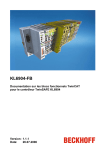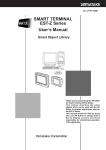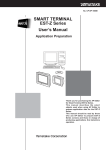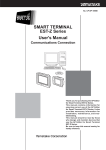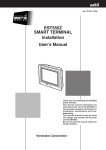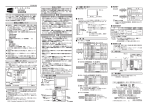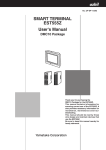Download Yamatake EST240Z Specifications
Transcript
No.SS2-FLC100-0010P Specification Harmonas-FLeX Distributed controller (FLC) 1. Introduction The FLC is a compact controller designed with an eye towards installation in a board. The FLC has the following functions and features: · · · · · · · · · · Control The FLC has functions equivalent to those of a full-scale process controller. It can be used for executing both PID control and sequence control and it is provided with various functions. Program creation and maintenance can be performed with the integrated engineering environment RTC. Debugging can be performed easily by conducting virtual simulation on a personal computer. Programs can be displayed with charts using the logic block and function block for easy observation. Created programs can be displayed in the form of drawings. Figure 1. Example of Installation in a Board Installation Compact type controller that can be installed in a small-size standard board (400 400). Mountable on an existing self-standing board or wall-hang board. Built-in external wiring terminal board, cable connecting the input/output card with the terminal board, power supply wiring for field device signal and short protection circuit. As it can be connected directly with the field wiring, installation is completed by just installing FLC and connecting the power supply with the field wiring. 368 input/output points at the maximum (approximately 256 points with a usual combination). Various types can be combined in accordance with the application. Environment-endurable design that allows operation in an encapsulated board. Figure 2. EST555Z/EST240Z Harmonas PlantWalker-HV System Compatibility Redundant controlling Ethernet is equipped for standard specifications. A programmable indicator [EST555Z] can be connected to perform graphic monitoring and collecting and storing data. This system can be used as a digital recorder. Developable to a system such as the cooperative automation system Harmonas by connecting a controlling Ethernet cable. The FLC can be introduced for each local board individually, making stepwise networking and systemization possible. Harmonas-FLeX Note: Refer to CP-SS-1800 for the specification sheet of the programmable indicator “EST555Z,” and to CP-SS-1700 for that of the “EST240Z.” Figure 3. ISystem Architecture 1 2. Functional Overview ·· ·· · The FLC consists of a main unit and three expansion units at the maximum, and each unit has 6 I/O slots to mount I/O cards. When using an expansion unit, mount an interface card for the expansion unit to an I/O slot of the main unit, and mount similarly an interface card for interfacing with the main unit to each expansion unit, and connect them with a dedicated cable. The remaining I/O cards can be combined with the following cards of the necessary number and mounted. AI [4 - 20 mA/1 - 5 VDC] : 8 points/card AO [4 - 20 mA] : 8 points/card RTD : 8 points/card DI : 16 points/card DO [Semiconductor output] : 16 points/card DO [Relay output] : 16 points/card (In relay output, one card occupies two slots.) Indicator I/F : 1 port/card (Mounted to the main unit.) In addition, Ethernet is adopted for the control network and connection to other systems, and information systems such as the cooperative automation system Harmonas can be made easily. The control network is provided with a dual port for the standard specification. ·· Specifications Table 1. Hardware Specifications Item CPU Specifications 32 bits Largest configuration when three expansion units are connected - 23 I/O cards at the maximum (When the EST is connected, 22 cards at the maximum.) - HLAI: 184 points (maximum), 8 points/card - AO: 184 points (maximum), 8 points/card - DI: 368 points (maximum), 16 points/card - DO: 368 points (maximum), 16 points/card Number of I/O points - RTD AI for room temperature: 184 points (maximum), 8 points/card, fixed range of - 20 to 80 Note: The maximum number of points shown above is the restriction for the mounted slots when three expansion base units are connected. A certain restriction on the number of cards for practical use may be given from the control functional performance point of view. Configuration with only the main unit - 6 I/O cards (5 cards if the EST is connected.) Table 2. Specifications for Communication Item Host communication (Harmonas system, etc.) Communication between controllers I/O communication Local indicator (EST) communication Specifications Ethernet 10 Mbps, 400 PPS at the maximum (parameter/second: 400 PPS in total with communication between controllers) Available through Ethernet, 400 PPS at the maximum (parameter/second: 400 PPS in total with host communication) Dedicated parallel bus (An I/O slot of the main unit is occupied for the interface with the expansion units. No occupancy on the expansion unit side.) 1:1 communication with the controller through RS232 or RS485 Models that can be connected are EST555Z and EST240Z. (An I/O slot of the main unit is occupied for the interface.) Table 3. Software Specifications Item Adjustment control point Adjustment control algorithm Control cycle Sequence Specifications Adjustment control point: 32 points Adjustment PV point: 32 points 19 types (48 formulas) Select the basic cycle from 0.1, 0.2, 0.5 and 1 second (CL is fixed to 1 second.) Partly, 0.1 second execution processing is possible (CL is also possible.) 128 (Maximum) 6080 MU: 18240 - 24480 statements (The CL memory has no relation with other functions and can be used as a dedicated memory.) 64 points 1024 blocks at the maximum 25 algorithms 128 points at the maximum 2048 blocks at the maximum SAMA function block 91 algorithms (When monitoring from the DOSS/HSS is necessary, it is allocated to the numeric value variable or the flag variable.) 256 points at the maximum Digital composite 8192(Note 1) + (80 ( number of sequences used) Numeric value variable 8192(Note 2) + (128 ( number of sequences used) Flag variable 32 points Timer variable Note 1: 3,000 points are for use by the user, and the rest is reserved for the system. Note 2: 3,000 points (including 512 for alarm) are for use by the user, and the rest is reserved for the system. Logic 2 Installation environment conditions Installation environment conditions for a single installation are shown in the following table. For a single installation, provide clearances of the specified dimensions around the main unit. In addition to the following conditions, pay appropriate attention to the external magnetic field, electrostatic discharge, radio interference, etc. Table 4. Installation Environment Conditions Item Ambient temperature (Note 1) Relative humidity Range ( Standard operating conditions Normal operating conditions Marginal operating conditions Conditions for storage and transportation 23 2 0 to 50 0 to 50 0 to 50 5 20 5 to 95 Note2 (0.020kg/kg') 0.35 mm or lower (2 to 9 Hz) 1m/s2 mm or lower (9 to 150 Hz) 20 5 to 95 (0.020kg/kg') 0.35 mm or lower (2 to 9 Hz) 1m/s2 mm or lower (9 to 150 Hz) 5 to 95 (0.020kg/kg') 1.5 mm or lower (2 to 9 Hz) 5m/s2 mm or lower (9 to 150 Hz) ) Rate of change ( /h) (% RH) 50 10 Amplitude 0 Acceleration 0 Vibration (Note 3) Note 1: The atmosphere for use shall not include any corrosive gas. It is recommended to install in the control panel with a temperature of 45 Note 2: Maximum relative humidity (ratio of mass, kg/kg between wet air and dry air) Note 3: Do not install in a place in which strong vibration is applied continuously. or lower. Input and output specifications Table 5-1. Input and Output Specifications Item Analog input specifications Number of points Input power supply voltage and consumption current Input signal Input range (FS) Accuracy Repeatability Insulation Input impedance Transmitter power supply Number of points Input power supply voltage and consumption current Temperature input (Room temperature, outside air Input signal temperature, etc.) Accuracy Insulation Allowable wiring resistance Analog output 24 VDC ( 10%, 70 mA (When the transmitter* power supply is not used.) 1 to 5 VDC (0 to 100%) 0.726 to 5.276 VDC ( - 6.9 to 106.9%) 0.5% F.S. (factory-shipped adjustment, under the environment of 25 2 0.5% F.S. Common insulation with the input power supply and system power supply Differential input for use between channels (allowable operating voltage 1 MΩ or higher 18.6 to 26.4 VDC, 200 mA or more at the maximum (8 points, prepared for each common card) 8 points 24 VDC 10%, 70 mA PT 100 Ω, New JIS - 20 to 80 , fixed range 1% F.S. (under the environment of 25 2 ) Common insulation with the input power supply and system power supply 5 Ω or lower 4 to 20 mA (0 to 100%) 2.9 to 21.1 mA (- 6.9% to 106.9%) 0.5% F.S. (factory-shipped adjustment, under the environment of 25 Repeatability Insulation 0.5% F.S. Common insulation with the input power supply and system power supply Maximum load resistance Number of points Input circuit Common Input power supply voltage and consumption current 300 Ω 16 points/card Photocoupler input (selectable for each source, or sink or card) 16 points common Input impedance Input filter time constant Insulation Input type ) 3 V) Number of points Output power supply voltage and consumption current Output range Output scope Accuracy Input signal Digital input Specifications 8 points/card 8 points/card 24 VDC 10%, 140 mA (at 100% output on all points) 24 VDC 2 ) 10%, 100 mA (When all points are ON.) ON: 18 V or higher (2.4 mA or higher) OFF: 6 V or lower (0.8 mA or lower) 6.8 kΩ 10 ms Insulated from the system power supply and not insulated from input power supply Status-type, or latch-type (push button) input or counter-type Specifiable for each point (depending on the software) Latch type DI input detection width 100 ms or more Integratable pulse width 100 ms or more (200 ms or higher at ON/OFF) *Remarks: The transmitter power supply is not insulated from the input power supply. When the transmitter power supply is used, the input side becomes common and differential input cannot be performed. When connecting a two-wire transmitter or 4 to 20 mA input, install a 250 ( resistor to the external terminal. 3 Table 5-2. Input and Output Specifications (Continued) Item Digital output Specifications Number of points 16 points/card Output circuit Open collector Common Output power supply voltage and consumption current 16 points common Maximum key current (load current) Maximum 0.5 A (for one point) Output transistor ON voltage Insulation 10%, 10 mA (When all points are OFF.) Maximum 2 A (for one card) 1.5 V or lower (When the load current is 0.5 A.) Pulse-type DO pulse width Number of points Insulated from the system power supply and not insulated from the output power supply Latch-type (status) output or pulse-type output, specifiable for output of each point (Depending on the software) 100 ms to 120 s, 100 ms resolution 16 points/card Output circuit Make (A contact) Output power supply voltage and consumption current 24 VDC Contact rating 250 VAC 2A (resistance load) 30 VDC 2A (resistance load) Operating time 10 ms or less Reset time Output transistor leak current Insulation 5 ms or less 1.5 V or lower (with 24 VDC) Insulated from system power supply and output power supply Output type, pulse width Same as open collector output Output type Digital output (When a relay terminal panel is used.) 24 VDC 16 points 10 %, approximately 150 mA (When relay 16 points excited) Model Table 6. List of Models varnish finished HD-FXFLC00P * * * * * Model * * * * Name Remarks Main unit: With field power supply HD-FXFLC00PE Main unit: With field power supply + With expansion unit I/F board HD-FXFLC00N Main unit: Without field power supply Controller/main unit (Either one shall be selected.) HD-FXFLC00NE HD-FXSWFLC20 Main unit: Without field power supply + With expansion unit I/F board FLC license Necessary for each main unit HD-FXFLE00P Expansion unit: With field power supply HD-FXFLE00N Expansion unit: Without field power supply HD-FXDCBX00 HD-FXEXPNL HD-FXCBL01 HD-FXCBL02 HD-FXCBL03 Expansion unit I/F board (3 ports on the main unit side) Front panel for connecting the expansion unit (A part on the main unit side) Expansion unit connection cable: 1 m Expansion unit connection cable: 2 m Expansion unit connection cable: 3 m HD-FXAIPS00 Controller/expansion unit (Either one shall be selected.) Necessary when connecting an expansion unit to the main unit without an expansion unit I/F Necessary when expanding the input/output Analog input card (with terminals) * HD-FXRTDPS0 * * * * * HD-FXAOPS00 Temperature measuring resistor card (Air conditioning specifications: - 20 to 80 , with terminals) Analog output card (with terminals) HD-FXDIPS00 HD-FXDOPS00 Digital input card (with terminals) Digital output card (SS output, with terminals) HD-FXDYPS00 Digital output card (with relay terminals) HD-FXESTS00 HD-FXWMCAB0S EST smart terminal I/F card Standard board (S size): Wall-hang board type: for installing EST240Z HD-FXWMCAB0M HD-FXWMCAB0L Standard board (M size): Wall-hang board type: for installing EST555Z Standard board (L size): Freestanding board type: for installing EST555Z HD-FXSWRTCF RTC_FLEX (software) : For varnish finished products, a "C" is affixed to the end of the model number. 4 Input/output card Necessary when connecting the EST Functions of each part Names of each part are shown in Figure 4. Breaker 24 VDC output connection terminals Field power supply (24 VDC) 100 VAC input connection terminals System power supply (3.3 VDC) Holes for mounting (4 places) Area to mount the terminal panel LED display, operation switches Side panel Front panel Cable shield Note 1: Wiring for 3.3V power supply for the controller is completed. Note 2: Connect the field 24 V power supply (2.2 A) to the feeder terminal on the specified terminal panel for each I/O module. Figure 4. Name of each Part of the FLC Functions of the display unit are as follows: POWER : Lights up when the power supply of the communication control unit is normal. RUN : Lights up while the control is being executed. SAVE : Lights up when the control database exists in the flash memory. Flashes during saving. ERR. : Flashes when any error occurs. Functions of the operating unit are as follows: RUN/STOP : Starts/stops the control and brings the system into idling status. LOCAL/RMT.: Switches to the LOCAL side when operating control start and stop with the above-mentioned switch; switches to the RMT. side when operating through the RTC. SAVE : Executes saving. Move the switch to the left and continue to hold it there until the SAVE LED starts to flash. When the switch is released, it returns to the right. · ·· · · · · 5 3. Control Functions Commanded state (OP) (from operator or user program) Control functions are classified into the following control points: Regulatory PV Point (RegPV) Standard I/O processing functions, like industrial unit conversion and alarm, are directly carried out by using I/O monitoring. The regulatory PV point achieves the process variable (PV) calculation and compensation functions. Algorithms such as flow rate compensation, integration and variable dead time compensation implement PV processing. It is available to provide more enhanced configuration such as alarm suppression, signal filtering, etc. Signal filtering, algorithm and calculation formula options. For available algorithm and other supported functions, see Table 7. Input (up to 2 inputs) Data acquisition Flow rate compensation Middle of three High/low/average selector Summer Integration (totalizer) Variable dead time Lead/lag compensation General linearization Calculator algorithm Support function Output (up to 3 outputs) 10 11 12 Override "Forced" Logic Point (Logic) Logic points are used together with digital composite points to provide interlock logic functions. A logic point has a processing equivalent of up to two pages of relay ladder logic. A logic point consists of a logic block, flag, numeric value variable, input connection and output connection. Three are three types of combinations in configuration of inputs, outputs, and logic block of a logic points. (See Table 9) In addition to the logic block functions, logic points are available as data transfer points. This reads data from input connections and makes an output connection of this data, so that the data can be transferred to a parameter of other defined databases. PV source(Automation, manual, substitution) PV clamp Engineering unit conversion and extended PV range check PV status PV filtering PV alarm - Bad PV - Upper and lower limits of PV - Upper-upper/Lower-lower limits of PV - PV rate of change alarm Table 9. Maximum Configuration Example of Logic Points Configuration Type Input Output Logic block 12 12 12 4 8 12 16 8 0 Option 1 Option 2 Option 3 Note: Each logic point provides six status flags, six user flags and four numeric value variables. Table 10. Logic Block Algorithm Table 8. Adjustment Control Points PID With PID field forward With PID external feedback Position proportion on/off control Ratio control Lamp/soak Automatic/manual station Speed type addition Switch Override selector Forced output Interlock Figure 5. Structure of Digital Composite Points Regulatory Control Point (Reg Ctl) Regulatory control points are used to carry out the control functions of FLC. Configuration of the algorithms listed in Table 8 carries out the regulatory control point functions. Each algorithm contains configurable options and achieves complicated control by a simple menu selection. Functions provided as standard functions include initialization and windup protection. The set point lamping (by operator entry of target values and lamp time) is also configurable. Available algorithm Operation permission Interlock P0 P1 P2 Permissive "Permission" Table 7. Regulatory PV Points Available algorithm Off nomal Command disagree Un-commanded change alarm Current status (PV) Support function Mode/mode attribute Red tag Initialization Windup protection Logic AND OR NOT NAND NOR XOR QUALIFIED-OR 2 (2-input majority decision) External mode switchover Safety cutoff Limit (output) PV source PV alarm - Bad PV - Upper and lower limits of PV - Upper-upper/Lower-lower limits of PV - PV rate of change alarm QUALIFIED-OR3 (3-input majority decision) Comparison EQ (= with dead band) NE ( with dead band) GT (> with dead band) LT (< with dead band) LE ( dead hand) DELAY Digital Composite Point (Dig Comp) Digital composite points are multi input and multi output points that provides interface to discrete equipment, like the motors, pumps and solenoid valves. These points provide interlock processing functions as standard functions. These points can also display interlock states on the screen of an open supervisory station. The displayed states have information effective for tracking the cause of interlock. The “ / local / hand / off / auto / ” switches generally used for motor driving equipment can also be handled. Figure 5 shows the major parameters related to this type of control point. Delay ON DELAY OFF DELAY FIXPLS (fixed length pulse) Pulse Watch dog timer MAXPLS (maximum time limit pulse) MINPLS (minimum time limit pulse) WATCHIDOG Flip flop Input error check Switch FLIPFLOP CHECKBAD SWITCH Change detection CHDETECT Note: AND, OR, NAND and NOR gates accept three inputs per block. Options are available to inverse inputs. 6 Function Block Point (FB) Function block point consists of 91 types of function blocks (see Table 11). Up to 2048 function blocks are available per point. Conforming to a block notation system called SAMA (Scientific Apparatus Makers Association), these function blocks can construct control functions by a logic diagram system. Table 11. Function Block Algorithm Arithmetic operation (8 types) Single number value variable (13 types) ADD (addition) SUB (subtraction) MUL (multiplication) DIV (division) MOD (modulo) EXPT (exponent xy) SUM (4-point addition) DADD (digital addition) ABS (absolute value) SQR (square) SQRT (square root) LN (logarithm natural) LOG (customary logarithm) EXP (exponent ex) SIN (sine) COS (cosine) TAN (tangent) ATAN (arctangent) TRUNC (truncation) ROUND (rounding) PSQRT (percent square root) Selection (9 types) Detection (12 types) MAX (maximum value) MIN (minimum value) AVG (average value) HSE (high selector) LSE (low selector) MID3 (middle of three) SW (switch) SFT (softening switch) ALSW (alternate switch) HLM (high limiter) LLM (low limiter) DRL (rate-of-change limiter) HMS (high monitor) LMS (low monitor) DRM (rate-of-change monitor) DMS (deviation monitor) NUMCHK (normality check) BADCHK (badness check) INFCHK (infinity check) QLTCHK (change check 1) CHGCHK (change check 2) ETP (% conversion) FUNC (function conversion) CONV (data type conversion) Conversion (4 types) PTE (EU value conversion) Logical operation (11 types) Comparison (6 types) Pulse (3 types) Timer (5 types) AND (logical product) OR (logical sum) NOT (inversion) NAND (inverted logical product) NOR (inverted logical sum) XOR (exclusive logical sum) QOR2 (2-input majority decision) SR (set) RS (reset) ORIN4 (4-input logical sum) ANDIN4 (4-input logical product) EQ (= with dead band) NE ( with dead band) GT (> with dead band) LE ( dead band) GE ( with dead band) LT ( < with dead band) FIXPLS (fixed length pulse) MAXPLS (maximum time limit pulse) MINPLS (minimum time limit pulse) CYCPLS (timer) WDT (watch dog timer) DELAY (delay) ONDLY (on delay) OFFDLY (off delay) Counter (4 types) UCNT (up counter) DCNT (down counter) AAV (analog integration) PAV (pulse integration) Control operation (8 types) PID (PID operation) PRO (proportion) INT (integration) DIF (differentiation) DLTPV (speed type PV) Others (7 types) LDLG (leading/delay) DED (waste time) TF (filtering time) RMP (lamp) MAV (movement average) ANMA (analog memory) GW (gate way) SG (single) FL (flag) TIMFL (one shot FL) REDTAG Process Module Data Point (Proc Mod) Process control often requires flexible control programs that are also available for continuous process, batch or hybrid applications. Process module data point is a user created program (CL program) written in special-purpose control language. This language provides powerful sequence control and calculation functions. CL programs can access analog input and output, digital input and output, logic block status, alarm status, failure status, numeric value variables, and flags. Process module data points provide phase, step and statement structures suitable for implementing batch process control functions. They can also activate a sequence for hold, shutdown, or emergency shutdown by means of the powerful function of the multilevel error processing. 4. Alarm System Functions FLC supports alarm functions. If alarms occur, these alarms are notified onto an open supervisory station via various types of screens. Alarms are generally classified into PV alarms and digital alarms. PV Alarm For access variables, configurable PV alarms are as follows. Methods are available for setting alarms in I/O points or in control points. In general, if a control point uses an I/O point, an alarm is set in a control point. Otherwise, it is set in an I/O point. High Change rate high High high Change rate low Low Significant change Low low A dead band can be set in all PV alarms mentioned above. ·· ·· Flag Point Flag points indicate two states, such as on and off, and accepts entries of Boolean algebra values. Flag points can be changed by operators and user programs. Per FLC, 8192 flags are prepared. Of these flags, the first 512 flags support off-normal alarms (generates alarm at status on). ·· · Digital Alarm Digital alarms are divided into the following three types: Off normal alarm Uncommanded change alarm Command disagree alarm Off normal alarms are simply generated when the status is on. Both uncommanded change alarms and command disagree alarms are set within digital composite points and detect a disagreement between input and output. A command disagree alarm detects a disagreement between input and output just after an output change, while an uncommanded change alarm detects a disagreement between input and output when no output change is made. Both alarms can set dead band time. ·· · Numeric Value Variable Point Numeric value variable points are numeric value variables that literally save real values and are effective for batch (recipe) operations. Per FLC, 8192 numeric value variable points are prepared. Like flag points, numeric value variable points are not included in the point processing schedule. Timer Point Timer points are effective for operators and user programs to supervise process events. Timer points are processed once every second. Per FLC, 32 timer points are prepared. 7 Alarm Priority Alarm priority can be configured for individual alarm types for each point. Selectable alarm priorities can be divided into the following five types: Emergent (emergency) Important (high) Ordinary (low) Record only (journal) Only journal printer output (not used when the EST is connected) Journal recording + printer output (not used when the EST is connected) None (no action) Processing Unit (PU Value) This unit represents the processing capability of FLC, determined based on the point types, control cycles, etc. PU values differ depending on point types and control cycles. The following table lists the maximum PU values per FLC and PU values at points. ·· ·· · · · Table 14. Maximum PU Value (Per FLC) Point Type Total of control points and function blocks and of I/O points 700 Table 15. List of PU Values of I/O Points PU Value Contact Cutout The contact cutout function allows a program to temporarily stop an alarm for each point having alarm functions. The “CONTCUT” parameter, prepared for the points having alarm functions, can be set to on to put the points in the alarm stop status. Device 5. Processing Performances Combining adjustment control loops, logic functions, sequence and I/O processes, FLC can configure control functions according to applications. The configuration needs to take into account restrictions on the maximum number of points per FLC, the processing unit (PU value), which is a unit of processing capability, and the memory unit (MU value), which is a permitted memory unit of CL program size. I/O Monitoring Cycle 1sec 0.5sec 0.2sec 0.1sec Main unit 2.0 Expansion unit (for each unit) 4.0 - Digital input (DI) (for each card) - 0.7 1.1 2.3 Digital output (DO) (for each card) - 0.2 0.4 1.0 4.3 2.0 Analog input (AI) (for each card) - 1.5 2.2 4.3 7.8 Analog output (AO) (for each card) - 0.3 0.6 1.5 3.0 Note: In AI, it is assumed that two alarms (occurrence or restoration) at a time occur every second in the 4 slots. In DI, it is assumed that one off-normal alarm at a time occurs every second in the 8 slots. Table 16. List of PU Values (Control Cycle = 1 sec) Control Point Name 1sec PU Value RegPV RegCtl Logic DigComp ProcMod(short) ProcMod(long) Maximum Number of Points The maximum number of points settable per FLC is as follows. Table 12. Maximum Number of Points (per FLC) Point type PU value 0.8 1.1 0.7 0.1 1.0 2.0 Maximum number of points Regulatory control Regulatory PV Process module Logic Digital composite Function block 32 32 128 64 256 128 Numeric value variable (NN) 8,192(Note 1) + (80 ( number of sequences used) Flag variable (FL) 8,192(Note 2) + (128 ( number of sequences used) Timer variable (TM) I/O point 32 (Number of points per module 24) Function Block ADD SUB MUL DIV MOD EXPT SUM DADD ABS SQR SQRT LN LOG EXP SIN COS TAN ATAN TRUNC ROUND PSQRT MAX MIN AVG HSE LSE MID3 SW SFT ALSW HLM Note 1: 2,047 points are for use by the user, and the rest is reserved for the system. Note 2: 2,047 points (including 512 for alarm) are for use by the user, and the rest is reserved for the system. Maximum Number of Blocks The following restrictions apply to the function blocks, components of function block points. Table 13. Maximum Number of Function Blocks Function block point Per point 2048 blocks Per FLC 2048 blocks 8 1sec, PU Value 0.027 0.027 0.027 0.027 0.022 0.027 0.031 0.031 0.018 0.018 0.018 0.027 0.027 0.027 0.027 0.027 0.027 0.027 0.027 0.027 0.018 0.031 0.031 0.031 0.027 0.027 0.031 0.027 0.044 0.022 0.018 Function Block LLM DRL HMS LMS DRM DMS NUMCHK BADCHK INFCHK QLTCHK CHGCHK PTE ETP FUNC CONV AND OR NOT NAND NOR XOR QOR2 SR RS ORIN4 ADDIN4 EQ NE GT GE LT 1sec, PU Value 0.018 0.044 0.018 0.018 0.044 0.027 0.018 0.018 0.018 0.018 0.027 0.022 0.022 0.031 0.035 0.022 0.022 0.022 0.022 0.022 0.022 0.027 0.022 0.022 0.031 0.031 0.027 0.027 0.027 0.027 0.027 Function Block LE FIXPLS MAXPLS MINPLS CYCPLS WDT DELAY ONDLY OFFDLY UCNT DCNT AAV PAV PID PRO INT DIF LDLG DED TF DLTPV RMP MAV ANMA GW SG FL TIMFL REDTAG 1sec, PU Value 0.027 0.027 0.027 0.027 0.031 0.027 0.018 0.031 0.031 0.022 0.022 0.031 0.031 0.083 0.027 0.053 0.070 0.044 0.040 0.053 0.027 0.035 0.048 0.031 0.022 0.018 0.018 0.031 0.018 Memory Unit (MU Value) Memory unit value is a unit value indication that helps user in using memory of FLC, this determines the total size of CL programs. Memory unit values are used to store CL programs themselves. For MU value calculation, a CL program is divided into three statements. An MU value is then found by the quantity of statements. Each division is called a CL block, with 1CL block = 1 MU. The maximum MU value per FLC is 6080. Different from PU values, MU values are not affected by control cycles or the number of I/O points. 6. Smart Debug The smart debug function can check operations of various control functions and I/O processing functions provided by FLC without using I/O modules. This function can be carried out per FLC. After the transition to the debug mode, the function neither receives inputs from I/O modules nor transmits outputs to I/O modules, except for performing controlling operations within FLC and I/O processing operation. Engineers can set any values on FLC as virtual process data, making the debugging of CL programs, etc., easy. Engineers can operate and supervise the status of the debug mode on the Harmonized supervisory station. Control Cycle Control cycles are selectable per FLC from among 1 sec, 500 msec, 200 msec and 100 msec (for combinations, see Table 17). In addition to the control cycles, some of the data points can be processed at high speed (100 ms) by means of fast scan function. 7. Software Simulation Table 17. Combination of Control Cycles SCANRATE Parameter Reg1 Log1 Reg1 Log2 Reg1 Log5 Reg1 Log10 Reg2 Log2 Reg2 Log5 Reg2 Log10 Reg5 Log5 Reg5 Log10 Reg10 Log10 Fast scan The software simulation function (option) allows standalone PCs to virtually carry out functions of FLC. Using this function enables creating and verifying (debugging) applications in an environment without actual machines. One PC can perform those operations for more than one FLC. Point Type 、 RegcTl、 RegPV 1sec 1sec 1sec 1sec 500msec 500msec 500msec 200msec 200msec 100msec 100msec 、 Logic、 DigComp 1sec 500msec 200msec 100msec 500msec 200msec 100msec 200msec 100msec 100msec 100msec PromMod 1sec 1sec 1sec 1sec 1sec 1sec 1sec 1sec 1sec 1sec 100msec FB Selection of the following control cycles per point ・1sec ・500msec ・200msec ・100msec 8. Restart The FLC restarts operation based on data from the flash memory on the CPU card (CTC) at a time of normal restart. It is designed so that, at restart, the necessary startup operations become minimal, while the status of the process is maintained. The control loop performing output to the field is switched into the manual mode, and the sequence can be selected from among automatic start from the beginning, stop at the first step, or stop at the last execution position. Data save to the flash memory can be manually performed with switches on the front panel of the controller or on the local indicator. 9. Connection of the expansion base units Main unit (master side) The expansion unit I/F board is mounted to the bottom I/O slot. The length of the cable must not exceed 3 m. Expansion unit -1 (Slave side) Expansion unit -2 (Slave side) Expansion unit -3 (Slave side) Install the main unit and the expansion units in the same board. Figure 6. Diagram for Connection of the Expansion Base Unit 9 10. Outer Dimensional Drawing 23 98 R4.5 13 13.5 9 18 280 310 Mounting surface 280 136 (127) 9 25 8 R4.5 325 *: The figure in the brackets is for models without the field power supply (24 V) Figure 7. FLC Outer Dimensional Drawing 10 (This page intentionally left brank.) 11 • Windows 2000, Windows, MS are trademarks of Microsoft Corporation of USA and other countries. • Ethernet is a trademark of the XEROX Corporation of USA. • Pentlium is a trademark of Intel Corporation of USA. • Other product names, model nos., company names are trademarks of each company. Specifications are subject to change without notice. Savemation Saving through Automation New Stage Yokohama Building 1-1-32, Shin-urashima-cho, Kanagawa-ku, Yokohama 221-0031, JAPAN Tel : 81-45-461-8823 http://jp.yamatake.co/ 0310-Y/Y This has been printed on recycled paper. 12












